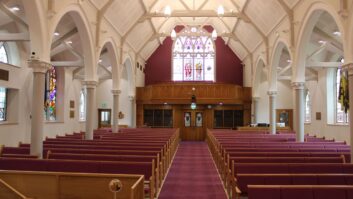In the frankly unlikely event that it has escaped the attention of any Installation readers, EN54 is the European fire safety standard incorporating detailed requirements for all component parts of fire alarm and voice alarm (VA) systems, reports David Davies. Since debuting in December 1996, the EN54 standard ‘family’ has grown to encompass more than 30 parts with far-reaching implications for specifiers, end-users and, in particular, manufacturers.
Much of the industry debate in recent years has revolved around Parts 16 and 24. The primary impetus behind these latest additions was the Construction Product Directive (CPD), requiring all projects to employ products that have been ‘type tested’ according to specified standards for efficiency or interoperability. Taking effect in April 2011, the CPD means that every building must have minimum prevention and protection from risks, and where an emergency arises, a method of alarm and escape to minimise the risk to people. Underlining the rapid pace of developments in this area, the CPD will be superseded in 2013 by the CPR (Construction Product Regulations).
Published in 2008, EN54-16 addresses components for fire alarm/voice alarm systems and VACIE (voice alarm control and indicating equipment). Mirroring the requirement for all fire alarm systems to be accredited by an approved testing house prior to sale, Part 16 means that VA systems now have to undergo a similarly rigorous process of assessment.
Approved simultaneously, EN54-24 stipulates requirements, test methods and robustness of voice alarm loudspeakers, along with their “performance under climatic and mechanical conditions which are likely to occur in the service environment”.
It would be no understatement to say that the arrival of 16/24 has attracted considerable confusion in the industry – from concerns about legal imperatives to actual dates of implementation. With these issues in mind, Installation decided it was high time to identify the primary areas of enduring doubt and go in search of answers from expert industry observers.
Next: When did EN54-16 and -24 actually come into effect?
@page_break@
1) When did EN54-16 and -24 actually come into effect?
EN54-16 and EN54-24 were approved in early 2008, but were accompanied by a two-year ‘crossover period’ (subsequently extended to three) that allowed manufacturers and test houses to undertake the necessary changes. The upshot is that this particular ‘brave new world’ truly began in earnest in April 2011, with integrators thereafter required to use compliant (or exempt) products in addition to complying with relevant installation and performance standards.
But with not all European countries signed up to the programme of European Directives (EDs), 16/24’s influence has hardly been consistent. “It’s really been a bit unclear for everyone,” says Tannoy product manager (pro-audio) Mark Copeland with admirable succinctness.
Moreover, observes Harman Professional market analyst Dave Leverett, “the extremely high cost of certifying products means there are relatively few products currently certified” (see box opposite for more on the certification process). The situation is exacerbated by the trend for some companies to advertise ‘EN54-compliant’ products, which, adds Leverett, is “a little misleading since the product is not technically legal unless it was tested and certified by an accredited test facility”.
Harman, for one, insists that it is well ahead of the curve here. Leverett highlights the fact that many of its products were “already certified to UL life safety standards, [meaning that] they often exceed EN54 standards without modification. In some cases, we have upgraded materials to increase the fire-retardant qualities of the speaker.”
But while these latest aspects of EN54 are now a part of everyday life, there is an “additional twist”, warns Steve Jones, consulting engineer and participant in the CEN TC72 WG3 European standards working group. Every standard has a ‘maintenance period’ of five years, meaning that every half-decade “the originating panel is required to review and either withdraw, amend or revise the standard”. Given that EN54-16 and -24 were approved by CEN in January 2008, this process should get underway during the first few weeks of next year.
Within six months of the review commencing, all relevant countries will undertake a vote to confirm whether the standards should be maintained for a further five years. A decision to withdraw them altogether is highly unlikely; a move to revise them less so. In the event of the latter outcome, the EN54 working group would be required to initiate an updated version, with a publication due date of 20 June 2016.
(To address another area of lingering doubt, it should be noted at this juncture that international standard IEC60849 – which specifies performance requirements for sound reinforcement systems used indoors or outdoors to broadcast information for the protection of lives within specified areas in an emergency – has been withdrawn.
However, the European harmonised version of EN60849, says Jones, “has not been withdrawn, as a result of objections from some countries – hence [we are] trying to revise it to remove any conflict with EN54 [thus making it the EN5 series]. The status is that the EN version is still in force and is still in conflict with EN54.” A proposed replacement, EN50849, was published as a DPC [Draft Publication for Comment] – the final stage before becoming a standard – but rejected by countries including the UK. As a result, EN60849 remains in force for now.)
Next: What is the legal status of EN54-16 and -24?
@page_break@
2) What is the legal status of EN54-16 and -24?
“The legal status of any standard is nil,” confirms Jones. “What happens is that legislation is brought in (nationally or Europe-wide) and this requires certain minimum efforts by those affected” – in this case, represented by the aforementioned CPD/CPR.
So far, so simple – but as Martijn van Overveld, EMEA product marketing manager public address & voice alarm at Bosch Security Systems, reminds, national law “determines whether or not an application requires a voice alarm system to be connected to a fire alarm system – [meaning that] the installation of EN54-compliant systems across Europe is not straightforward.”
Further capacity for doubt is provided by the possible contention in some scenarios that a ‘kit’ system is being used to make a voice alarm, instead of a VACIE – thereby possibly negating the requirements of EN54. There are also specific exemptions for self-powered and ‘special application’ speakers.
In reality, the CPR derives much of its substance from a requirement stating that the objective of minimising risk is likely to be achieved to an adequate degree if the products used are tested in a consistent fashion and carry the CE mark to demonstrate it. Accordingly, EN54 states that the products in each category may only display the CE mark if they have been type-tested to the relevant part of EN54.
Unfortunately, cautions Jones, that is not the end of the matter. In addition to all products needing to feature the CE mark if they are to be sold in Europe, the type-tested ones must also carry a code. As a result, if the client “wants to ensure that he is not sued (under the Regulatory Reform Act) then he must post a man to check all products coming to site and that they have the correct CE mark”.
Perceived in one way, EN54 is primarily a manufacturers’ responsibility. But as van Overfeld points out: “The total central system (central equipment including installation in the racks) is regarded as being subject to EN54. Therefore, the standard goes beyond only product certification, and so designers and installers have to be aware of what they can and cannot do.”
The upshot is that there is an onus on installers and end-users to seek expert guidance with a keen eye on those ‘worst-case scenarios’. In this regard, manufacturers are certainly playing their part, with Bosch among those to have issued dedicated brochures and a booklet explaining the status of the standards. In addition, throughout 2012, the company is implementing EN54 in product training “to safeguard that products are EN54-certified and that the systems consisting of components are working correctly and according to EN54-16”.
Next: What impact are the standards having on tender documents?
@page_break@
3) What impact are the standards having on tender documents?
The consensus view is that EN54 is now factored into the vast majority of project specifications throughout Europe. But differing levels of competence mean that its implementation is – to put it mildly – the subject of variation.
“Although we see that the majority of the specifications do require an EN54 certified system, when it comes to ordering and supplying, most of the installations do not comply simply because the installers have poor understanding of what the EN54 standard consists of,” says Albert van der Hout, international sales and marketing manager at voice alarm and sound installation technology specialist Ateïs International. “What’s clearly missing are education and control.”
Jones’s experience tells him that both consulting and electrical engineers are frequently lacking in detailed understanding of the standards’ requirements. For example: “The electrical engineer Googles voice alarm standards and up pops EN54 along with BS5389. A quick look at the descriptors and in its goes to the specification.”
He acknowledges some familiar, large-scale construction and design outfits’ dedication to ensuring that “every necessary box is ticked”, but worries that the standards’ high profile is in danger of undermining overall system effectiveness.
“It is often the case that neither the fire alarm manufacturer’s rep or, more importantly, the electrical engineer actually understands what the standard says, nor what to look for in the special CE mark,” maintains Jones. “The only true test for being ‘fit for purpose’ (a legal definition of guilt or innocence) is not a marking, but intelligibility. In my view, the standards are weakening the system by imposing criteria which take the focus away from the effectiveness of the resultant system.”
Next: Where do we go from here?
@page_break@
4) Where do we go from here?
The EN54 family will shortly be joined by Part 32, which pertains to the planning, design, installation, commissioning, use and maintenance of voice alarm systems. Currently under preparation, EN54-32 is a Technical Standard (TS) that will elaborate upon minimum performance criteria.
Most observers agree that the new part will be useful. “The 54-32 has better explanations and has parts for predictive methods as they are already applied in the fire alarm industry,” says van der Hout. “Unfortunately, it will not make a difference to the system design and implementation… The PA/VA industry has a lot of work to do in [terms of] educating its clients.”
Pointing out that 32 has “no teeth” within the framework delivered by the CPR, Jones makes a call for 32 to be rendered a full standard as one aspect of a personally devised manifesto that also includes the reworking of EN54 per se (making it “as black and white as it can possibly be”) and the introduction of a central, EU-funded scheme to ensure that the standards are delivering “an effective means of communication under emergency conditions”.
EN54 remains a significant source of stress for installers and specifiers. But it is the manufacturers who must bear the greatest weight – one that is only exacerbated by enduring doubts about the standards’ long-term relevance.
Jones sums up: “The nagging feeling is the uncertainty whether the EN54 will still be around in 10 years’ time, or whether the manufacturer will still be around in 10 years’ time because they spent their money in the wrong direction. It’s a real sleep-thief.”
www.ateis-international.com
www.boschsecurity.co.uk
www.harmanpro.com
www.jonesthesound.com







